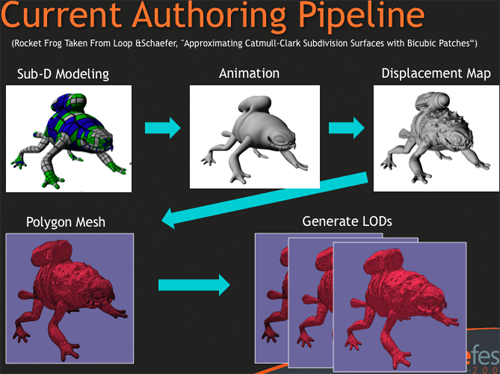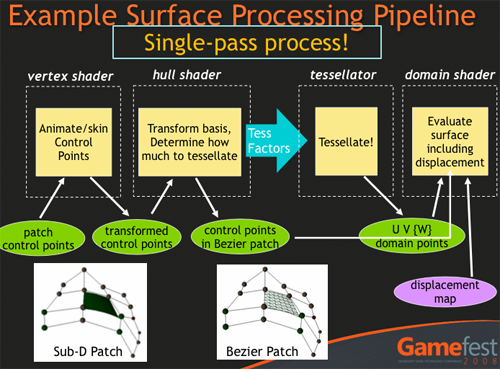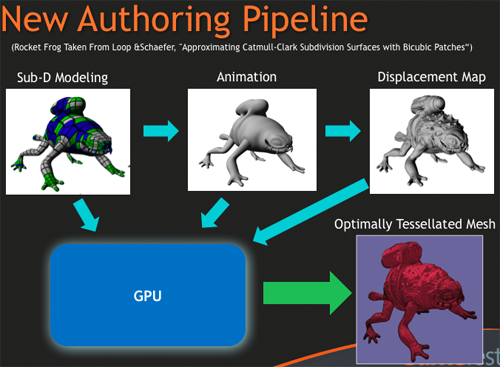Tessellation: Because The GS Isn't Fast Enough
Microsoft and AMD tend to get the most excited about tessellation whenever the topic of DX11 comes up. AMD jumped on the tessellation bandwagon long ago, and perhaps it does make sense for consoles like the XBox 360. Adding fixed function hardware to quickly and efficiently handle a task that improves memory footprint has major advantages in the living room. We still aren't sold on the need for a tessellator on the desktop, but who's to argue with progress?
Or is it really progressive? The tessellator itself is fixed function rather than programmable. Sure, the input to and output of the tessellator can be manipulated a bit through the Hull Shader and Domain Shader, but the heart of the beast is just not that flexible. The Geometry Shader is the programmable block in the pipeline that is capable of tessellation as well as much more, but it just doesn't have the power to do tessellation on any useful scale. So while most everything has been moving towards programmability in the rendering pipe, we have sort of a step backward here. But why?
The argument between fixed function and programmable hardware is always one of performance versus flexibility and usefulness. In the beginning, fixed function was necessary to get the desired performance. As time went on, it became clear that adding in more fixed function hardware to graphics chips just wasn't feasible. The transistors put into specialized hardware just go unused if developers don't program to take advantage of it. This made a shift toward architectures where expanding the pool of compute resources that could be shared and used for many different tasks became a much more attractive way to go. In the general case anyway. But that doesn't mean that fixed function hardware doesn't have it's place.
We do still have the problem that all the transistors put into the tessellator are worthless unless developers take advantage of the hardware. But the reason it makes sense is that the ROI (return on investment: what you get for what you put in) on those transistors is huge if developers do take advantage of the hardware: it's much easier to get huge tessellation performance out of a fixed function tessellator than to put the necessary resources into the Geometry Shader to allow it to be capable of the same tessellation performance programmatically. This doesn't mean we'll start to see a renaissance of fixed function blocks in our graphics hardware; just that significantly advanced features going forward may still require the sacrifice of programability in favor of early adoption of a feature. The majority of tasks will continue to be enabled in a flexible programmable way, and in the future we may see more flexibility introduced into the tessellator until it becomes fully programmable as well (or ends up just being merged into some future version of the Geometry Shader).

Now don't let this technical assessment of fixed function tessellation make you think we aren't interested in reaping the benefits of the tessellator. Currently, artists need to create different versions of their objects for different LODs (Level of Detail -- reducing or increasing complexity as the object moves further or nearer the viewer), and geometry simulation through texturing at each LOD needs to be done by pixel shaders. This requires extra work from both artists and programmers and costs a good bit in terms of performance. There are also some effects than can only be done with more geometry.

Tessellation is a great way to get that geometry in there for more detail, shadowing, and smooth edges. High geometry also allows really cool displacement mapping effects. Currently, much geometry is simulated through textures and techniques like bump mapping or parallax occlusion mapping or some other technique. Even with high geometry, we will want to have large normal maps for our lighting algorithms to use, but we won't need to do so much work to make things like cracks, bumps, ridges, and small detail geometry appear to be there when it isn't because we can just tessellate and displace in a single pass through the pipeline. This is fast, efficient, and can produce very detailed effects while freeing up pixel shader resources for other uses. With tessellation, artists can create one sub division surface that can have a dynamic LOD free of charge; a simple hull shader and a displacement map applied in the domain shader will save a lot of work, increase quality, and improve performance quite a bit.

If developers adopt tessellation, we could see cool things, and with the move to DX11 class hardware both NVIDIA and AMD will be making parts with tessellation capability. But we may not see developers just start using tessellation (or the compute shader for that matter) right away. Because DirectX 11 will run on down level hardware and at the release of DX11 we will already have a huge number cards on the market capable of running a subset of DX11 bringing with it a better, more refined, programming language in the new version of HLSL and seamless parallelization optimizations, we will very likely see the first DX11 games only implementing features that can run completely on DX10 hardware.
Of course, at that point developers can be fully confident of exploiting all the aspects of DX10 hardware, which they still aren't completely taking advantage of. Many people still want and need a DX9 path because of Vista's failure, which means DX10 code tends to be more or less an enhanced DX9 path rather than something fundamentally different. So when DirectX 11 finally debuts, we will start to see what developers could really do with DX10.
Certainly there will be developers experimenting with tessellation, but these will probably just be simple amplification to get rid of those jagged edges around curved surfaces at first. It will take time for the real advanced tessellation techniques everyone is excited about to come to fruition.










109 Comments
View All Comments
ssj4Gogeta - Saturday, January 31, 2009 - link
oh ok. thanks. :)PrinceGaz - Friday, January 30, 2009 - link
I was aware of the idea of the Tesselator in AMD's DX10.1 hardware, but this article was excellent in putting everything together in how it will (or might) function in the DX11 pipeline, and everything else associated with the additions DX11 builds on top of DX10, and the reasons behind what has been done and the implications of it.This is definitely up there with the best of the articles Anand himself posts here; well done Derek. It was the sort of article that first made AT my favourite site to visit first for reviews-- in depth and written by someone who knew what he was talking about. Thankyou.
PrinceGaz - Friday, January 30, 2009 - link
Just because you don't use like it doesn't mean that lots of people are using it day-in day-out on PCs it was pre-installed on. Admittedly I dual-boot Vista and XP, and 99 times out of 100 it is XP (the Vista installation is only used either to help my father when speaking on the phone and who bought a laptop with Vista last year, or to run 3DMark Vantage), but Vista is very popular with most people who use it. My father hasn't any complaints with it (okay so he hasn't used any other O/S, but does that matter).Personally, I intend to jump from XP to Win7 SP1 when it is released. My current Vista installation is 64-bit Ultimate SP1 and it works, but with only 2GB of RAM, I find that XP does everything just as well or better. I would say Vista is very successful though, as almost all computers sold with Windows today have Vista installed rather than XP. There are probably more computers now sold with irrelevant OS's like Linux or OS/X, than there are those that come shipped with XP (netbooks excluded).
PS: actually I like some Linux distros, so if you found the previous paragraph at all offensive, I apologise. But the average user isn't going to want a PC with a Linux distro, unless it comes fully pre-configured with every app they need pre-installed.
ameatypie - Tuesday, February 3, 2009 - link
sorry, but i completly disagree with this. Vista is RUBBISH. If you use it on your average comuter, it is slow. If you use it on a computer worse then that, it is worse then slow - it is useless. If you use it on a fast computer, it wastes half the reasorces that get thrown at it and it doesnt use the other half efficantly enough.The only reason people now days are using vista is because they are forced to with new computers - espically laptops.
I have seen the windows 7 beta, and THAT is going to be pretty good........ But vista is still RUBBISH. :P
just4U - Wednesday, February 4, 2009 - link
No one is FORCED to use Vista and it's certainly NOT rubbish. It is definitely a step way up from XP. I am using the Win7 Beta right now and it's a improvement but why anyone would say its pretty good and Vista is not is beyond me as they are very similiar.I really do think all the Vista bashing has come from people who just don't use it or never really gave it much of a chance. NO instead they go back to (what one user said..) That Bastion of security and stability ... Windows XP. Note the sarcasm. Xp was good for it's time but Vista blows it out of the water.
nilepez - Wednesday, February 4, 2009 - link
By average, do you mean a processor slower than a Athlon 64 3000+ and a 4 year old graphics card?Just curious, because I've got a machine like that that has no problems running Vista (and gets an Vista Experience score between 4 and 5).
Clearly your idea of average is a machine that was, at best, average 4 years ago.
Zoomer - Monday, February 2, 2009 - link
Well, if you throw lots of ram (8GB), fast new graphics card, and use nLite to remove/disable crap like UAC, Defender, firewall, readyboost, and make programs run with administrator privileges by default, it's usable.Nothing like Ubuntu though. However, Ubuntu doesn't run games, or rather, developers don't write mainstream 3D games for it, so I just use VMs or remote connections.
One thing I have not figured out is to change the mouse behavior in windows to more closely resemble linux: mouse wheel should scroll the window the pointer is hovering over, regardless of the active window. Unfortunately, it doesn't seem possible. Therefore, Vista sucks. ;p
gochichi - Thursday, February 19, 2009 - link
Ubuntu is also bloated. I mean, I can't get my hard drive to stop making noises on Ubuntu.. NOR on Vista... which annoys me to no end. I was finally able to stop the noises in Vista but Ubuntu still grinds it away.Ubuntu is the stuff though. I run Office 2003 on it using Wine and that runs great. But the truth is that Office 2007 is actually better and so Vista is better. you start taking games into account and Windows is clearly the best period... consoles and everything... I'll take a Windows box anyday.
Ubuntu is here to stay, it's getting better every six months. Because Windows XP hasn't died and refuses to die... it gives the open source community time to play catch up. Like Wine, it can reach Windows XP status and if it does (when it does, hopefully before Windows XP is totally dead) it'll be a great option.
Ubuntu is always a great option, the problem is that Microsoft OSs are as "free" money-wise because they come preloaded on 99% of PCs. They only people buying separate versions of Microsoft OSs are Apple users (the irony! OH THE IRONY!) and the handful of people builiding their own systems.
The typical case is like my laptop. By default Vista Home Premium... and it does dual boot to Ubuntu sometimes mostly for my Unix class. I think it's a joy to use it either way, but Ubuntu doesn't have any price advantage at all. And it never will because it's cheaper for Dell (in this case) to pay Microsoft the OEM fee for Vista (or Windows 7 in the near future) than it is to offer the technical support on Ubuntu. Vista (even Vista) also gives the system synergy and enhances the value of the hardware which more than justifies the OEM fee. I like dual booting, and I know that I'd get better at Ubuntu if I didn't have Vista but I find dual booting too irresistible.
So Ubuntu is great, it can't be denied. And one of these days Wine (the windows "not" emulator) might catch up enough so that productivity software can run better on Ubuntu than on Windows XP. Windows XP is Microsoft's Achile's Heel.
Because if new Macs didn't run Windows XP in a virtual machine as well as they do, they wouldn't be so widely adopted.
Windows XP symbolizes the overall lack of progress in the industry, and other companies are approaching its usability or swallowing it whole (like through a VW like with Macs and Fusion etc).
Overall, the computer industry has stagnated. Windows 7 might help, and DirectX11 might help, but I think it'll just keep things from slowing down so rapidly. So they'll continue to slow down, just less quickly.
ameatypie - Tuesday, February 3, 2009 - link
but then, how many people apart from myself and a few select others are going to throw 8GB of RAM, an 8800GT or higher series graphics card, and a beefy quad core at it? not many, if any.nilepez - Wednesday, February 4, 2009 - link
1. You don't need that for Vista.2. 8GB of ram can be had for under 100 bucks
3. Vista would run fine on a $20.00 PCI-e card
4. Vista ran fine with a 6600gt or a X800 card (both over 2 years old by the time Vista was generally available).
If you're talking about a card for gaming, well that has little to do with Vista and most tests now show that games run about the same on XP and Vista. This is no different htan XP upon release. It took a year or 2 before games ran about as well on XP as 9x.